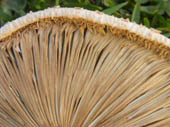
Purpose
To record the spore prints left behind by mushrooms.
Additional information
Spore prints can be used to help identify the type of mushroom or fungi by it's color. Capturing spore prints is both interesting and fun, and the end result can be used artistically to produce unusual patterns on posterboard. Additionally, you can study the pattern of the spore by optionally placing a small glass slide over the middle of the spore. This allows for examination under a microscope.
Sponsored Links
Required materials
- Open mushrooms
- Black and white posterboard
- Notebook
- Pen or pencil
- Plastic cups or plastic containers
- Hair spray
- Magnifying glass (optional)
Estimated Experiment Time
About 10 to 20 minutes to set-up, several days for the spore prints to form and dry.
Step-By-Step Procedure
- 1. Gently pull out the stems of the mushrooms so that you are left with the caps. If you have a magnifying glass, look under the mushroom caps and observe the frilly soft bits known as "gills".
- 2. Place the mushroom caps with the gills facing down on the black and white posterboard.
- 3. Cover the mushroom caps with the plastic cups or plastic containers.
- 4. Wait 24 hours and check to see if you can see spore prints on the posterboard. If there is nothing there, leave it an additional 24 hours and check again the next day. Keep checking until you can see spore prints on the posterboard.
- 5. Once the prints show up clearly, remove the mushroom caps and let the posterboard sit an additional 24 hours for the spore prints to dry.
- 6. Stand at least 12 inches from the posterboard and spray your spore prints with hair spray to preserve them.
Note
Using black and white poster board is important in finding out if the mushroom print has a pigmentation. If you do not have black and white posterboard, favor using a pure white posterboard for best results on the print.
If you have access to microscope glass slides (blank) you can place a slide over the spore print and cut it out for view under a microscope!
Observation
How do you suppose the spore prints would look if you tried using multi-colored posterboard to capture the prints? What can the spore prints tell you about the mushroom?
Result
Spores are similar to plant seeds. Mushrooms and other fungi produce spores that drop from their gills. The fallen spores deposit on the ground or are carried by the wind and deposited into other areas. These spores produce new mushrooms and fungi, much like plant seeds produce new plants.
Sponsored Links
Take a moment to visit our table of Periodic Elements page where you can get an in-depth view of all the elements,
complete with the industry first side-by-side element comparisons!